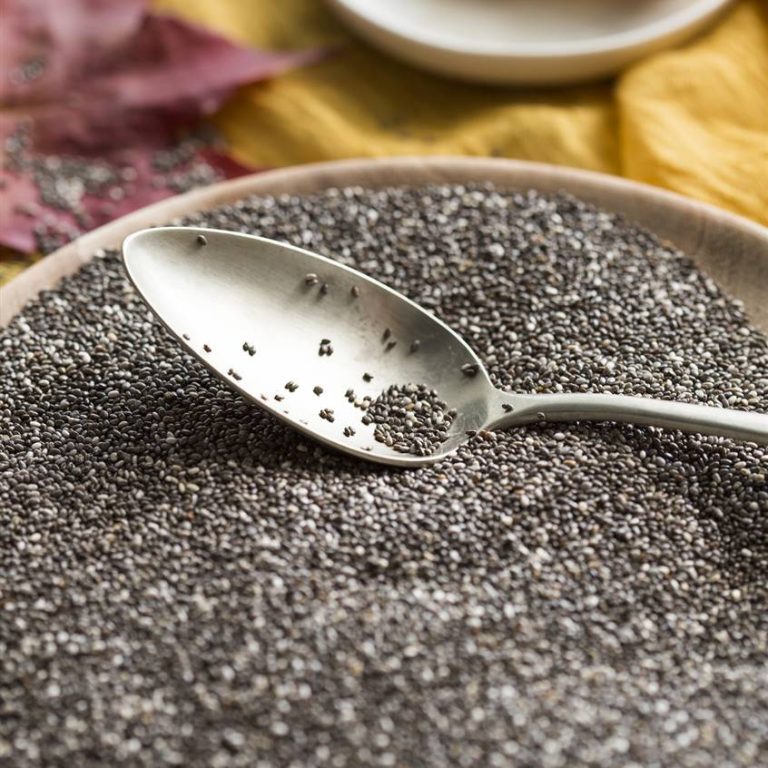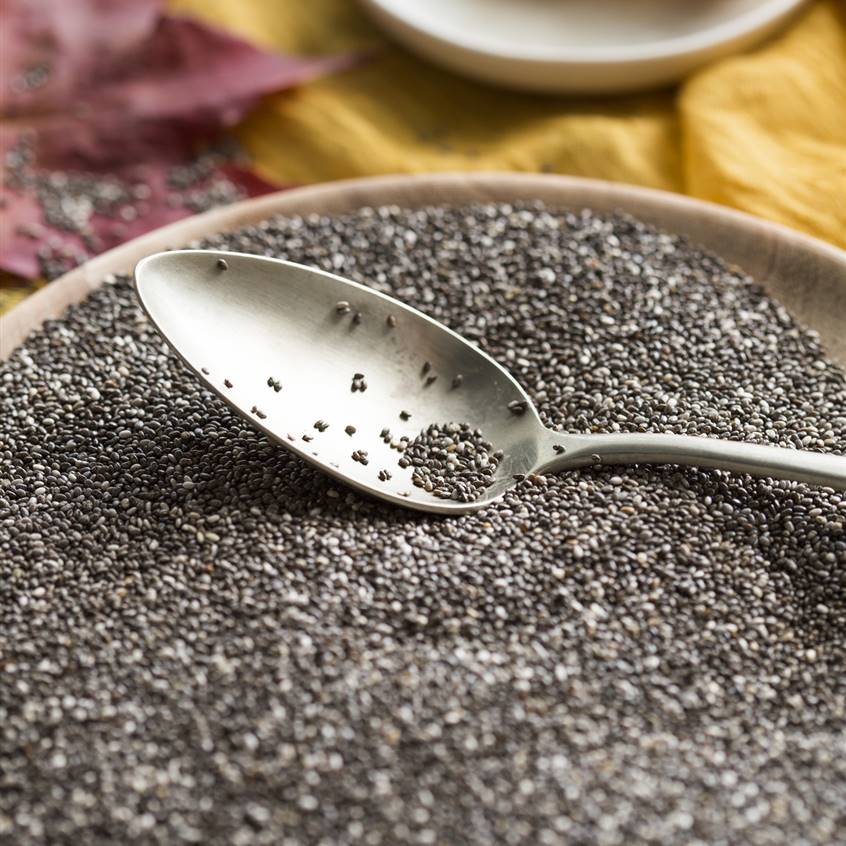
CHIA SEEDS: RECIPES Chia is the star of the vegetable omega-3. Its properties make it suitable for weight loss, relieve constipation, lower cholesterol and regulate sugar.

Its antioxidant potential, its beneficial effects on diabetes, cholesterol or hypertension and its anti-inflammatory and laxative properties, among others, are supported by scientific evidence, according to a review of studies published in the Journal of Food Science and Technology.
CHIA SEEDS: PROPERTIES AND BENEFITS
Chia is a seed especially rich in omega-3 fatty acids of vegetable origin, but also provides them with omega-6 fatty acids in the ideal ratio for the body, which is a ratio of 3 to 1 (omega-6 and omega-3). It is also a good source of minerals such as calcium, magnesium and boron.
In it we also find a high content of fiber, both soluble and insoluble, which helps us stay satiated and regulate intestinal transit. A serving of 30 grams (about two tablespoons) can contain up to 12 grams of fiber.
Unlike other seeds, chia also has a large number of antioxidants, which among other things prevent the rancidity of its own fats. Among its antioxidants, substances such as chlorogenic acid, caffeic acid, quercetin or kaempferol stand out.
1. PROTECTS THE HEART AND LOWERS CHOLESTEROL
The benefits of chia seeds are due to the high content of omega-3, an essential fatty acid with anti-inflammatory, antithrombotic and vasodilatory properties that helps regulate blood pressure and blood cholesterol: it decreases LDL lipoproteins and increases HDL.
Its high fiber content and the presence of beta-sitosterol’s, plant compounds that are beneficial in coronary heart disease and high cholesterol, also contribute to this.
2. REGULATES INTESTINAL TRANSIT
The high concentration of mucilage, a type of soluble fiber that grows in contact with water, causes chia seeds to increase tenfold in size in the digestive tract and press on the intestinal walls.
In this way, they stimulate peristalsis or movement of the intestines and improve constipation. These mucilages in turn create a viscous network that hydrates and lubricates the gastrointestinal tract, which also facilitates the expulsion of feces.
3. HELPS IN DIABETES
Chia is a good complement in the diet of people with diabetes, again because of the large amount of fiber it contains. It helps regulate blood sugar levels in general, as fiber captures some of those sugars and releases them slowly, which prevents spikes in blood glucose and insulin.
It is advisable to incorporate the seeds in fruit compotes, in fruit puddings or in stews of legumes and cereals.
4. WEIGHT LOSS
Among the benefits of chia seeds is to help in weight loss. This is because it fills the stomach and gives us a feeling of satiety thanks to its great ability to absorb liquids. And, as it regulates blood sugar levels, it helps prevent cravings for sweets.
5. ANTIOXIDANT PROTECTION
Recent studies show that chia has a high concentration of phenols, antioxidants that slow down up to 70% of free radical activity. This helps prevent premature aging of the skin and repair muscle tissues.
6. TAKE CARE OF YOUR BONES
With only 30 grams of chia, we obtain 20% of the recommended amount of calcium, an essential mineral to maintain bone mass and structure.
It also provides boron, which helps metabolize calcium.
If you want to start including chia in your dishes to start enjoying its properties, we tell you how to cook chia seeds and we give you a list of delicious and easy chia recipes:
- 4 breakfasts with chia to start the day right
- 3 Easy to Make Chia Pudding Recipes
- 3 recipes with chia for constipation
- 3 recipes with chia rich in omega-3
- 4 original and nutritious recipes with chia
ORIGIN OF CHIA
The benefits, both nutritious and medicinal, of these small black seeds from a plant native to Mexico and Guatemala (Salvia hispanica), have been known for thousands of years. In fact, chia was an important part of the Mayan and Aztec diet.
CAN YOU DRINK CHIA EVERY DAY?
Chia has multiple benefits and can be part of the daily diet.
It is high in fiber: it contains between 34 and 40 g of fiber per 100 g, equivalent to 100% of the daily recommendations for adults. Because of this, eating too much chia can cause diarrhea, bloating, and gas.
WHAT IS THE AMOUNT OF CHIA THAT CAN BE CONSUMED PER DAY?
According to the United States (2000) dietary guidelines, chia can be used as the main food, but an intake of no more than 48 g per day is recommended.
You can start with an approximate amount of 25 grams a day and see how your body responds.
HOW DO YOU EAT CHIA, RAW OR COOKED?
Chia seeds are eaten raw, adding them to various foods such as cereals, yogurt, smoothies… or as a salad dressing.
They can be soaked in a liquid, either water, yogurt or a juice, to turn them into a pudding or a gel-like substance. Chia seeds contain a high amount of mucilage (25%), a type of fiber that, when in contact with water, forms a viscous gel. In fact, chia can absorb 12 times its weight in water.
Chia seeds can also be ground and used to season stews, in pastry or in laxative infusions.
Chia seed gel can be used as an egg substitute in baked pastry products, to make them vegan-friendly and to reduce their caloric and fat content.
HOW LONG SHOULD CHIA BE LEFT TO SOAK?
By macerating the chia in water, a gel is created that you can take alone or add to juices, creams … You just have to put two tablespoons of chia seeds in a glass of water and let them stand for about 15-20 minutes.
- You can also pour them directly into a juice, yogurt or vegetable milk and wait about 15-20 minutes for them to swell.
WHICH PEOPLE SHOULD NOT CONSUME CHIA?
Omega-3 in large amounts can have blood-thinning effects and, if you are taking blood-thinning medications you should consult your doctor before including a lot of chia in your diet, as it could affect the functioning of your medication.
People with dysphagia (trouble swallowing), it is not recommended that they take the dried seeds (without hydrating). The American College of Gastroenterology’s 2014 Annual Scientific Meeting presented the case of a man with this condition who ate dried chia seeds and then a glass of water. The seeds expanded into his esophagus and got stuck.
In addition, chia contains a plant compound called phytic acid that can reduce the absorption of minerals such as iron and zinc.
WHAT ARE THE SIDE EFFECTS OF CHIA?
Chia consumption is considered safe in most people. However, as with most foods, some people may have allergies. Symptoms of an allergic reaction to chia may include itchy mouth, followed by generalized hives, skin reactions, shortness of breath and dizziness.